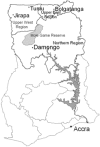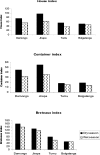Surveillance of viral haemorrhagic fevers in ghana: entomological assessment of the risk of transmission in the northern regions
- PMID: 17496987
- PMCID: PMC1868007
- DOI: 10.4314/gmj.v40i3.55269
Surveillance of viral haemorrhagic fevers in ghana: entomological assessment of the risk of transmission in the northern regions
Abstract
Summary objectives: To assess the risk of transmission of viral haemorrhagic fevers in northern Ghana.
Design: A two-year cross-sectional entomological study was carried out in four communities in the northern part of Ghana. Standard WHO methods were used to collect adult and larvae of Aedes mosquitoes to estimate man-vector contact rates and larval indices.
Results: A total of 2804 households were surveyed to estimate larval indices and man-vector contacts of potential vectors of viral haemorrhagic fevers such as Yellow fever and Dengue. Over 56% households in each study site were positive for Aedes larvae. Relatively higher Breteaux index (BI) and Container index (CI) were estimated in Damongo (BI: 180 and CI: 44.8) and Jirapa (BI: 149.7 and CI: 41.5) compared to Tumu (BI: 76.1 and CI: 19.5) and Bolgatanga (BI: 72.4 and CI: 20.6). Man-biting rates of 9.8 and 18.5 bites /man/hour were estimated for Damongo and Jirapa respectively whilst Bolgatanga recorded 10 B/M/H. Generally, man-vector contact rates in all the study sites were higher during the dry season than the wet season. Larval indices showed seasonal variations and the dry season was identified as the high-risk period for transmission of viral haemorrhagic fevers and possible disease outbreaks. No flavivirus was detected in the 2034 Aedes mosquitoes from the study sites by RT-PCR.
Conclusions: Aedes mosquito larval densities and adult biting rates, in all the study areas were sufficient to promote outbreaks of viral haemorrhagic fevers.
Figures
Similar articles
-
Risk of transmission of viral haemorrhagic fevers and the insecticide susceptibilitystatus of aedes aegypti (linnaeus) in some sites in Accra, Ghana.Ghana Med J. 2016 Sep;50(3):136-141. Ghana Med J. 2016. PMID: 27752187 Free PMC article.
-
Larval occurrence, oviposition behavior and biting activity of potential mosquito vectors of dengue on Samui Island, Thailand.J Vector Ecol. 2001 Dec;26(2):172-80. J Vector Ecol. 2001. PMID: 11813654
-
Assessment of risk of dengue and yellow fever virus transmission in three major Kenyan cities based on Stegomyia indices.PLoS Negl Trop Dis. 2017 Aug 17;11(8):e0005858. doi: 10.1371/journal.pntd.0005858. eCollection 2017 Aug. PLoS Negl Trop Dis. 2017. PMID: 28817563 Free PMC article.
-
[Reflection on 2 current viral diseases: yellow fever and dengue].Ann Biol Clin (Paris). 1997 Sep-Oct;55(5):415-24. Ann Biol Clin (Paris). 1997. PMID: 9347008 Review. French.
-
Fevers: Their Diagnosis, Pathology and Treatment.Ill Indiana Med Surg J. 1846 Oct;1(4):328-340. Ill Indiana Med Surg J. 1846. PMID: 37262548 Free PMC article. Review. No abstract available.
Cited by
-
Review of the ecology and behaviour of Aedes aegypti and Aedes albopictus in Western Africa and implications for vector control.Curr Res Parasitol Vector Borne Dis. 2022;2:100074. doi: 10.1016/j.crpvbd.2021.100074. Curr Res Parasitol Vector Borne Dis. 2022. PMID: 35726222 Free PMC article.
-
Spatiotemporal distribution and insecticide resistance status of Aedes aegypti in Ghana.Parasit Vectors. 2022 Feb 19;15(1):61. doi: 10.1186/s13071-022-05179-w. Parasit Vectors. 2022. PMID: 35183249 Free PMC article.
-
Entomological surveillance on Aedes aegypti during covid 19 period in Cape Coast, Ghana: Risk of arboviral outbreaks, multiple insecticide resistance and distribution of F1534C, V410L and V1016I kdr mutations.PLoS Negl Trop Dis. 2023 May 31;17(5):e0011397. doi: 10.1371/journal.pntd.0011397. eCollection 2023 May. PLoS Negl Trop Dis. 2023. PMID: 37256856 Free PMC article.
-
Evidence of chikungunya virus infections among febrile patients at three secondary health facilities in the Ashanti and the Bono Regions of Ghana.PLoS Negl Trop Dis. 2021 Aug 30;15(8):e0009735. doi: 10.1371/journal.pntd.0009735. eCollection 2021 Aug. PLoS Negl Trop Dis. 2021. PMID: 34460820 Free PMC article.
-
Arbovirus Epidemiology: The Mystery of Unnoticed Epidemics in Ghana, West Africa.Microorganisms. 2022 Sep 27;10(10):1914. doi: 10.3390/microorganisms10101914. Microorganisms. 2022. PMID: 36296190 Free PMC article. Review.
References
-
- Monath TP. Pathobiology of the flaviviruses. In: Schlesinger S, Schlesinger MJ, editors. The Togaviridae and Flaviviridae. New York: Plenum Press; 1986. pp. 375–442.
-
- Addy PAK, Minami K, Agadzi VK. Recent yellow fever epidemics in Ghana (1969–1983) East African Med J. 1986;63(6):422–433. - PubMed
-
- Burton GJ, Noamesi GK, McRae TM. A survey for the vector of yellow in the Damongo area, northern region, Ghana. Ghana Med J. 1964:9–15.
LinkOut - more resources
Full Text Sources
Miscellaneous



